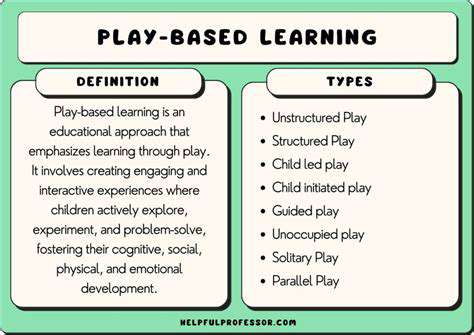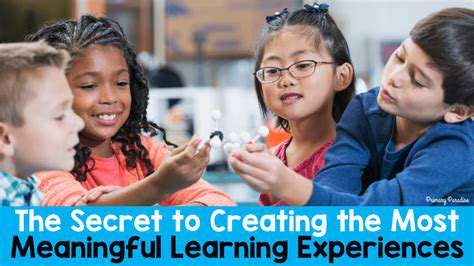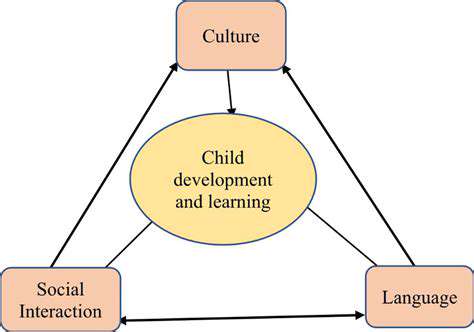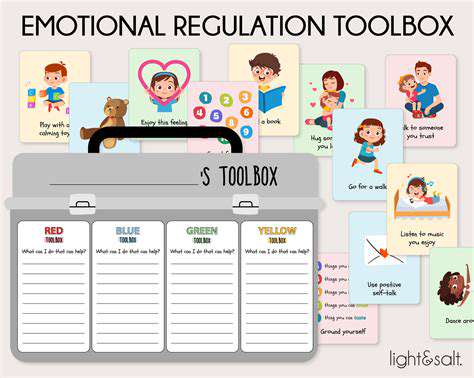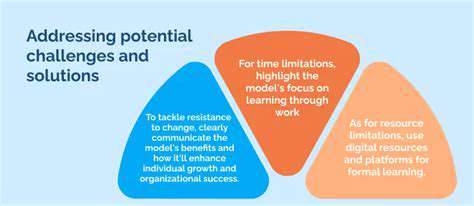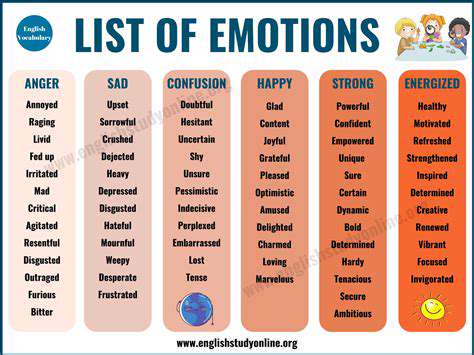Understanding and Managing Tantrums: A Parent's Compassionate Guide
Understanding the Underlying Needs
Children, especially toddlers and preschoolers, are still developing the language and communication skills necessary to express their needs and feelings effectively. When they're frustrated, overwhelmed, or simply don't know how to articulate their desires, tantrums can be the result. Understanding this developmental stage is crucial to recognizing that these outbursts are often a cry for help, rather than simply bad behavior. It's important to approach the situation with empathy and patience, rather than judgment.
Often, the underlying issue isn't just about the immediate trigger, but also about unmet needs for comfort, security, or autonomy. A child who feels ignored or unheard might react with a tantrum, showcasing their emotional vulnerability.
Recognizing the Triggers
Understanding the specific triggers that lead to tantrums can be a powerful tool in managing them. It's important to observe and document patterns in your child's behavior. Are there specific situations, like bedtime, mealtimes, or transitions between activities, that frequently precede tantrums? Are certain requests or demands particularly challenging for them? By identifying these patterns, you can anticipate potential triggers and develop strategies to prevent or mitigate the tantrum's intensity.
For example, a child might have a tantrum when asked to put away toys because they are deeply engaged in play and feel a sense of loss related to their activity. Understanding that attachment to play is a major source of comfort to the child can help the parent to better address the need for maintaining engagement in a healthy way.
The Role of Sensory Overload
Sensory overload can be a significant contributor to tantrums in young children. Loud noises, bright lights, or unfamiliar textures can overwhelm a child's senses, leading to a feeling of being overwhelmed and a subsequent emotional response. Recognizing this can help parents create a more calming environment, adjusting lighting, noise levels, and textures to help the child feel more comfortable and less stressed.
Developing Coping Mechanisms
Helping children develop healthy coping mechanisms is essential for managing tantrums. This involves teaching them how to recognize and manage their emotions. Simple strategies, like deep breathing exercises, counting to ten, or using calming sensory tools, can provide children with tools to navigate challenging situations. Consistency and repetition are key in helping children internalize these techniques.
The Importance of Emotional Regulation
Emotional regulation is a crucial skill that children are still developing. Tantrums often stem from an inability to effectively regulate emotions, especially negative ones like frustration, anger, or fear. Parents can help by modeling emotional regulation themselves, demonstrating healthy ways to manage their own emotions, and teaching children to identify and label their feelings. This can involve using specific words to describe the emotion they are experiencing, such as I'm feeling frustrated because... or I'm feeling sad because...
Creating a Supportive Environment
A supportive environment is vital for a child's emotional well-being and can significantly reduce the likelihood of tantrums. Creating a structured routine, providing clear expectations, and ensuring that children have opportunities to express their needs can significantly contribute to a more peaceful atmosphere. This also involves creating a home environment that fosters a sense of security, predictability, and respect. Being able to anticipate potential stressors and adapt the environment accordingly can alleviate much of the pressure on the child.
Seeking Professional Guidance
If tantrums are frequent, intense, or significantly impacting daily life, seeking professional guidance from a pediatrician, child psychologist, or therapist is recommended. These professionals can assess the situation, provide personalized strategies, and offer support to both the child and the parents. They can help identify any underlying issues or developmental concerns that may be contributing to the tantrums, and provide tailored interventions to help the child and family develop effective coping mechanisms.
Strategies for Managing Tantrums: A Calm Approach
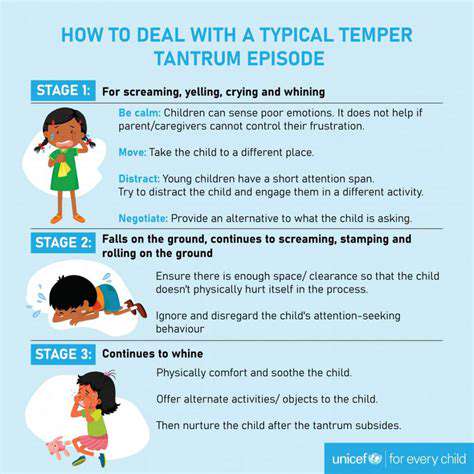
Understanding the Root Causes
Tantrums, while frustrating for everyone involved, are often a cry for help from a child who is overwhelmed or unable to effectively communicate their needs. Understanding the underlying reasons behind these outbursts is crucial to managing them effectively. This might involve hunger, tiredness, or a lack of understanding of social cues. Recognizing these potential triggers allows parents and caregivers to anticipate and address them proactively.
Sometimes, tantrums can be a manifestation of a child's frustration with developmental challenges. They might be struggling with a specific skill or feeling unable to cope with a situation beyond their current abilities. A thorough understanding of the child's developmental stage and individual temperament can provide valuable insights into the root cause of the tantrum.
Creating a Calming Environment
A child experiencing a tantrum needs a space where they can feel safe and secure to regulate their emotions. Creating a calm and supportive environment can help to diffuse the situation and encourage a return to a more peaceful state. This might involve removing them from stimulating environments, providing a quiet corner, or engaging in a calming activity.
Minimize distractions and loud noises to help focus on de-escalation. Soft lighting and soothing music or sounds can also create a more tranquil atmosphere.
Responding with Empathy and Patience
Responding with empathy and patience is crucial during a tantrum. It's important to avoid getting drawn into the child's emotional intensity, instead focusing on providing a supportive presence. Validating their feelings, even if you don't necessarily agree with their behavior, is essential. Acknowledge their distress without judgment or criticism.
Avoid lecturing or scolding during the outburst. Instead, focus on offering reassurance and support as they work through their emotions.
Distraction and Redirection Techniques
Distraction can be a valuable tool for redirecting a child's attention away from the source of their frustration. Identifying a suitable distraction, such as a favorite toy, a book, or a game, can help to shift their focus and calm their emotions.
Redirection techniques can be incredibly useful in preventing escalating tantrums. This involves subtly guiding the child's attention towards a different activity or object, offering an alternative choice that aligns with their preferences.
Positive Reinforcement Strategies
Positive reinforcement strategies can be incredibly effective in encouraging and rewarding appropriate behaviors. When a child manages their emotions or handles a situation calmly and cooperatively, acknowledging and rewarding their behavior can reinforce these positive actions.
This can include verbal praise, small rewards, or special privileges. Consistent application of these strategies strengthens positive behaviors and helps build a more emotionally intelligent child.
Setting Clear Expectations and Limits
Setting clear expectations and limits can help children understand acceptable behavior and the consequences of their actions. This helps them feel more secure and in control of their environment. Establishing rules and boundaries creates a predictable structure that helps reduce emotional outbursts.
By communicating these expectations clearly and consistently, children can better understand what is expected of them and how to manage their behavior appropriately. This fosters self-regulation skills and reduces the likelihood of future tantrums.
Seeking Professional Guidance
If tantrums are frequent, intense, or significantly impacting family life, seeking professional guidance from a child psychologist or therapist is recommended. They can provide specialized support and strategies tailored to the specific needs of the child and family.
A professional can offer valuable insight into underlying issues or developmental challenges that might be contributing to the tantrums. They can also provide support and guidance for parents and caregivers in developing effective coping mechanisms and strategies.
Responding with Empathy and Validation: A Compassionate Approach
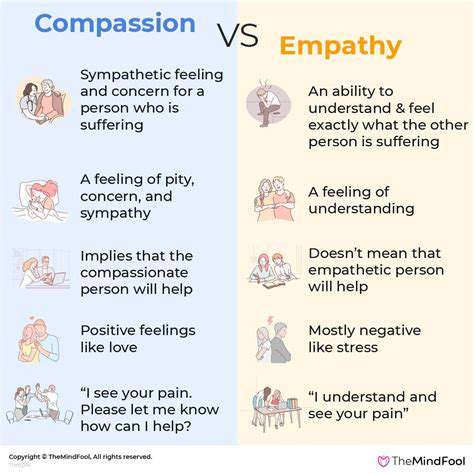
Understanding the Importance of Empathy
Empathy plays a crucial role in effective communication and interpersonal relationships. It involves the ability to understand and share the feelings of another person. This ability to step into someone else's shoes allows us to connect on a deeper level and respond in a way that is supportive and validating. Truly understanding another person's perspective is essential for building trust and fostering positive interactions. Empathy is not simply about feeling sorry for someone; it's about truly recognizing and acknowledging their experience.
Developing empathy requires active listening and a willingness to consider different viewpoints. It's about going beyond simply hearing words and trying to grasp the underlying emotions and experiences that drive them. This active engagement with others' feelings is vital for creating a safe and supportive environment.
Recognizing and Validating Feelings
Validating someone's feelings means acknowledging and accepting their emotions, even if you don't necessarily agree with their perspective or experience. Crucially, validation does not require agreement; instead, it focuses on recognizing the legitimacy of their emotional response. This is a fundamental aspect of showing empathy and creating a safe space for open communication.
Validating feelings is about showing respect and understanding for the other person's emotional state. It helps to de-escalate conflicts and build stronger connections.
Active Listening Techniques
Active listening is a crucial component of responding with empathy and validation. It involves focusing intently on what the other person is saying, both verbally and nonverbally. Paying close attention to their body language and tone of voice can provide valuable insights into their emotional state. This technique allows you to better understand their perspective and respond in a manner that is supportive and validating.
It also includes reflecting back what you've heard to ensure you've understood correctly. This demonstrates that you're engaged and invested in the conversation. This practice helps avoid misunderstandings and fosters a more empathetic environment.
Responding with Compassionate Language
Choosing compassionate language is paramount when responding with empathy. Avoid judgmental statements or dismissive remarks. Instead, focus on using phrases that acknowledge and validate the other person's experience. This could include phrases like, I understand that this is a difficult situation for you or It sounds like you're feeling really frustrated.
Using I statements can also be helpful. These statements express your own feelings and perspectives without placing blame or judgment on the other person.
Nonverbal Communication and Body Language
Nonverbal communication plays a significant role in conveying empathy. Maintaining eye contact, using open body language, and offering a supportive posture can all contribute to creating a sense of connection and understanding. Nonverbal cues often communicate more than words and can significantly impact how your message is perceived. Paying attention to your own nonverbal cues is just as important as understanding those of the other person.
Building Trust and Rapport
Responding with empathy and validation helps build trust and rapport. Consistency in demonstrating these qualities reinforces the idea that you care about the other person's experience and well-being. This consistent approach fosters a supportive environment where open communication and mutual understanding thrive. Building trust and rapport is essential for maintaining healthy relationships and resolving conflicts effectively.
By consistently demonstrating empathy and validation, you create an environment where individuals feel safe to express themselves and build strong connections.
Overcoming Challenges in Demonstrating Empathy
Demonstrating empathy can sometimes be challenging, especially when faced with difficult or emotionally charged situations. It's important to recognize that empathy isn't always easy and to allow yourself space to process your own emotions while still responding with compassion. Acknowledging personal limitations can help you to navigate these situations more effectively. Seeking support from others or practicing self-care can also be beneficial strategies for maintaining emotional well-being while engaging in empathy-focused interactions.
Remember, empathy is a skill that can be developed and refined over time. Practice and reflection are key to becoming more proficient in responding with empathy and validation.
Preventing Tantrums: Proactive Strategies for a Calmer Home

Understanding the Triggers
Tantrums, while frustrating for both parents and children, often stem from underlying needs that aren't being met. Understanding these triggers is crucial to preventing them. A child might be overwhelmed by a situation, feeling frustrated with a task, or experiencing a sudden change in routine. Identifying these triggers will allow for proactive measures to be put in place to avoid the tantrum altogether.
Recognizing the signs that a child is becoming overwhelmed or frustrated can be the first step in preventing a tantrum. Pay attention to subtle cues like increased restlessness, whining, or a change in body language. By anticipating these signals, parents can intervene before the tantrum escalates, potentially avoiding the outburst altogether.
Creating a Predictable Routine
Children thrive on routine and predictability. A structured daily schedule can help reduce anxiety and uncertainty, decreasing the likelihood of tantrums. Establishing clear expectations and routines for meals, playtime, and bedtime can provide a sense of security and control for the child, which can significantly reduce the potential for meltdowns.
Consistent routines provide a sense of stability, allowing children to feel more secure in their environment. This predictability can alleviate anxiety and frustration, making it easier for children to navigate their day without resorting to tantrums.
Responding to Needs Appropriately
Frequently, tantrums are a way for children to communicate their needs, which might not be verbally expressed. When a child is having a tantrum, it's important to try and understand the underlying need, whether it's hunger, tiredness, or a desire for attention. Addressing these needs calmly and effectively can often diffuse the situation before it escalates into a full-blown tantrum.
By actively listening to the child's cues and needs, parents can better understand the root cause of the tantrum and respond in a way that addresses the underlying issue, potentially preventing future occurrences. Responding with empathy and patience can foster a stronger parent-child relationship and help teach children healthy ways to express their emotions.
Building Emotional Regulation Skills
Teaching children emotional regulation strategies is essential for preventing tantrums. This involves helping them identify and label their emotions, and develop healthy coping mechanisms for dealing with difficult feelings. Simple techniques, like deep breathing exercises, can help calm a child down when they're feeling overwhelmed.
Developing these skills empowers children to manage their emotions constructively, reducing the likelihood of resorting to tantrums as a way to express their feelings. Encouraging open communication about feelings and providing positive reinforcement for managing emotions effectively are crucial for long-term success.
Providing Choices and Control
Giving children a sense of control over their environment can significantly reduce the likelihood of tantrums. Offering choices, even small ones, can empower them and make them feel heard and respected. This could involve letting them choose between two different activities or clothing options. Offering choices empowers children and reduces their frustration when faced with situations they feel they have no control over.
When children feel empowered and heard, they are more likely to feel a sense of security and cooperation. Giving them a voice in their day-to-day activities can foster a sense of responsibility and autonomy, significantly reducing the frequency and intensity of tantrums.

